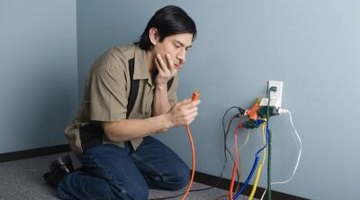How to Replace a Two-Prong Power Cord With a Three-Prong
Power cord plugs are outfitted with either two or three prongs, with the three-pronged variety used for safety in large appliances such as washers and dryers. The extra prong, which is round instead of flat, grounds the appliance and prevents electric surges, and each prong has a separate wire that attaches to it. If you have an older appliance with a two-prong plug, you can upgrade it to a three-prong plug. This allows you to plug the appliance into a newer three-prong outlet.

Step 1
Unplug the two-prong cord from the outlet and pull the appliance away from the wall if needed, so that you have plenty of room to work.
Step 2
Cut the cord off approximately a half inch above the plug, using wire cutters. Discard the old plug. Cut through the cord cleanly all at once to avoid fraying the wires.
Step 3
Open the new three-prong plug and look near the prongs to locate three small screws. Remove each screw using a screwdriver and set them aside in a safe area. Pull the center prong section out of the plug housing. Insert the cut end of the cord through the back of the plug housing.
Step 4
Remove one inch of the plastic coating from the end of the cord using a utility knife or a wire stripper. Use care not to damage the internal wires as you do this. Locate the three inner wires, which are white, black and green. Strip another half inch of the plastic coating off the end of each wire.
Step 5
Wrap the white wire end around the silver screw on the back of the pronged portion and tighten the screw using a screwdriver. Attach the black wire to the gold screw and the green wire to the green screw in the same manner.
Step 6
Push the pronged section of the plug back into the rear housing and reinsert the three screws in the front to hold it together.
Step 7
Look at the back of the plug to see if you find a two-part clamp there. If so, hold the clamp together and tighten the screw on either side using the screwdriver.
Check out this related video from Homesteady on Youtube.
Writer Bio
Kimberly Johnson is a freelance writer whose articles have appeared in various online publications including eHow, Suite101 and Examiner. She has a degree in journalism from the University of Georgia and began writing professionally in 2001.
Photo Credits
- Thinkstock Images/Comstock/Getty Images
More Articles



